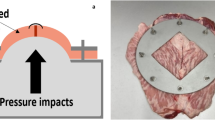Abstract
Ideal suturing was defined as advancing a needle along its curvature (needle circle) to minimize tissue trauma, while placing the suture with its intended span and tissue bite in the expected place. Actual suture tracks were analyzed to find the keys to produce such suturing. Correspondence of those tracks to the ideal track was then determined by the span, the initial needle angle (IA) into the tissue, and the center of the needle circle. Eight surgeons with 4–7 years of experience produced 22 ideal sutures in two types of tissue simulants: The entrance and exit points of the needle were level in flat suturing, while the entrance point was slanted 45 degrees for slant suturing. The correspondence was better with slant suturing than flat suturing (P<0.01). The IA in flat suturing was 49.0±2.0 (mean±SE) degrees versus 33.0 for ideal suturing (P<0.01), while that in slant suturing was 35.5±1.9 (P: ns). In conclusion, the IA was the key to good results, and was optimized in slant suturing, which was instinctively utilized in practice by using forceps. The forceps avoided a derangement of suturing stemming from the configuration of the needle employed and from the range of motion of the surgeon's arm (human engineering), while satisfying the surgeons inclination to take a large IA.
Similar content being viewed by others
References
Seki S (1987) Accuracy of suture placement. Br J Surg 74:195–197
Seki S (1987) Accuracy of suture techniques of surgeons with different surgical experience. Jpn J Surg 17:465–459
Seki S (1988) Suturing techniques of surgeons utilizing two different needle-holder grips. Am J Surg 155:250–252
Seki S (1988) Techniques for better suturing. Br J Surg 75:1181–1184
Seki S (1989) Técnicas para perfeccionar la sutura. Br J Surg 1:233–236
Seki S (1989) Suturing techniques of individual surgeons — Difference in accuracy and mechanics. Jpn J Surg 19:424–431
Seki S, Iwamoto H, Osaki K (in press) Suturing techniques for a restricted operating space. International Surgery
Hollinshead WH (1982) Anatomy for surgeons, 3rd edn. Harper and Row, Philadelphia, pp 341–436
Marcus E, Zimmerman LM (1960) Principles of surgical practice. McGraw-Hill, New York
Schwartz SI (1979) Principles of surgery, 3rd edn. McGraw-Hill, New York
Chassin JL (1980) Operative strategy in general surgery. Springer, Berlin, Heidelberg, New York
Sabiston DC (1981) Davis-Christopher textbook of surgery — The biological basis of modern surgical practice — 12th edn. WB Saunders, Philadelphia
Sabiston DC, Spencer FC (1983) Gibbon's surgery of the chest, 4th edn. WB Saunders, Philadelphia
Trott A (1991) Wounds and lacerations — Emergency care and closure. Mosby-Year Book, St. Louis, pp 66–79
Lammers RL (1991) Soft tissue procedure. In: Roberts JR, Hedges JR (eds) Clinical procedures in emergency medicine. WB Saunders, Philadelphia, pp 515–565
Author information
Authors and Affiliations
Additional information
This study was supported, in part, by Grants (Research C Nos. 02807128, 1990 and 03670657, 1991) from the Ministry of Education, Science and Culture, Japan
Rights and permissions
About this article
Cite this article
Seki, S., Iwamoto, H., Osaki, H. et al. The surgeon's technical skill in suturing: An analysis of the actual suture tracks. Surg Today 23, 800–806 (1993). https://doi.org/10.1007/BF00311623
Received:
Accepted:
Issue Date:
DOI: https://doi.org/10.1007/BF00311623




